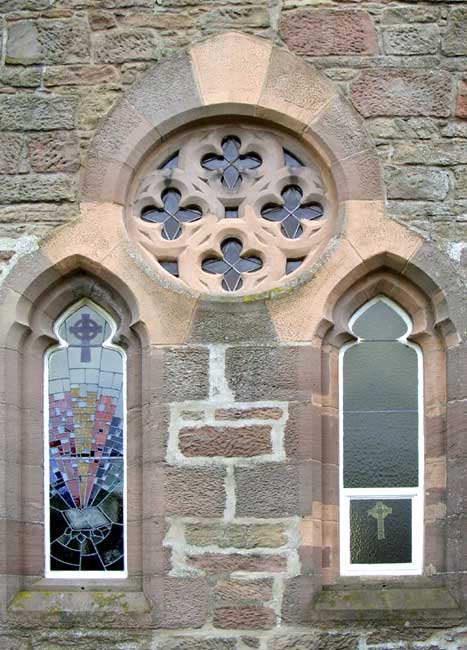Location
Arbuthnott Place - in the town centre of Stonehaven,
Stonehaven, Kincardine
OS Map Reference
NO 876 856
Date
Various
Description
The Church of the Immaculate Conception is the last remaining place of worship in Stonehaven's Old Town. It boasts details recognised as deriving from Notre-Dame-le-Grand, Poitiers and Chartres and despite the loss of some original glazing is nevertheless an important quiet place on its island site surrounded by roads and behind the High Street. The building date varies from 1875 to 1879 depending upon the source, but it is a certainty that funds for this fine church and the nearby Rickarton Cottages were provided by Mrs Eliza Maria Hepburn of Rickarton, as a memorial to her daughter. A sketch in Christie's 'Haven Under The Hill', entitled 'Church of St Mary' shows decorative ridge detail and a ship weathervane, neither of which are evident today (2004). He also mentions an American organ which was installed in April 1880. The priest´s house is located at the nearby (separately listed) Rickarton Cottages and is accessible from the church grounds. The nearby soup kitchen was presented to the church by George Blackie in 1905.
GENERAL: Architect J. Russell Mackenzie, 1877. Small, elaborately-detailed gothic church with 3-bay aisles nave, traceried and arcaded front, shallow gabled transepts, semicircular apse, polygonal baptistery and 4-stage buttressed tower with belfry and octagonal pinnacled spire. Coursed, squared and snecked rubble with ashlar dressings. Deep base and eaves courses. Traceried circular openings, cusped lancets. 2-stage, sawtooth-coped and pinnacled buttresses. Voussoirs; chamfered reveals and raked cills. Timber doors with decorative ironwork.
GLASS: Coloured glass to NE traceried window depicting St Margarita (St Margaret Queen of Scotland, Saint Margaret (c. 1045 – 16 November 1093, canonised in 1251 by Pope Innocent IV); leaded diamond pattern glazing to apse and baptistry; some openings reglazed; figurative coloured glass lancet to SE transept (see Interior). Grey slates. Ashlar-coped skews. Cast-iron downpipes with polygonal rainwater hoppers.
INTERIOR: fine plain interior with moulded cornice, hammerbeam roof and decorative timber braces, timber pews and boarded dadoes; transept with double arch springing from low column with moulded capital. Apsidal chancel with elegant braced timber roof on stone corbels. Lancet to SE transept 'Come Holy Spirit' by Edinburgh Stained Glass House, 2003.
SOUP KITCHEN: Single storey, slated, rubble cottage known as 'soup kitchen'.The Soup Kitchen is now used as a meeting room. Work began on the Kitchen on 24th December 1904 on three days weekly, and closed on 18th March 1905.
The Kitchen was used in the 1940s but is thought to have ceased work in 1946. The building was then used for various purposes, and the Mearns Leader reported a visit by an interested townsperson in 1983 to the wood store.
Related Information
The church is also known as St. Mary's R.C. Church.
The following taken from Stanehyve Magazine No 44 Summer 2002:
"Eliza Maria of Rickart Estate was a Catholic and used part of the sale proceeds of the estate to build a Catholic church in Stonehaven and also the row of cottages in front of it, still called Rickarton Cottages, one of which is the presbytery."
St Margaret Queen of Scotland, Saint Margaret (c. 1045 - 16 November 1093, canonised in 1251 by Pope Innocent IV), was the sister of Edgar Ætheling, probably born in Hungary, the heir to the Anglo-Saxon Throne of England. She married Malcolm III, King of Scots, becoming his Queen consort. popularly regarded as initiating a demise in Gaelic language and culture in the southern Scottish aristocratic context with subsequent Anglification. She has been referred to in Gaeldom as Mairead/Maighread nam Mallachd: Accursed Margaret. This reputation is probably rather unfair as much more significant changes (seen as good bad or indifferent according to the linguistic, cultural and political prejudices of the author) took place during the reign of her youngest son King David I, (reign 1124-1153), sometimes referred to as the "Davidian Revolution", although modern historical views tend to place less responsibility for widespread cultural/linguistic/political change on single individuals.
Era
Various
Information Source
Stanehyve Magazine Nos44, 52, Listed Building Record, http://en.wikipedia.org/wiki/Saint_Margaret_of_Scotland
Related Artefacts
Categories
Iconography
- bird
- book
- cross, Celtic
- cross, Greek
- human face or head
- human figure
- plant
- religious figure
Creators
- J. Russell Mackenzie, Architect
- Edinburgh Stained Glass House, Manufacturer
Photographer
- Pat Copner
Unavailable Data
- External Links
This content was submitted by external contributors and does not necessarily reflect the views of the University of Aberdeen.









